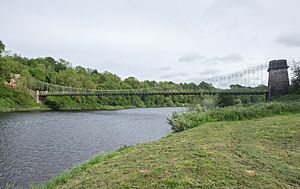Fishwick, Scottish Borders facts for kids

Fishwick is a small area in the Scottish Borders, Scotland. It's part of what's known as a parish, which is like a local district. Fishwick is located about seven miles from the town of Berwick-upon-Tweed. Long ago, there was a small medieval village here, but it has now disappeared. Today, Fishwick is mostly made up of farms and scattered houses.
Fishwick sits right next to the River Tweed. This river forms the border between Scotland and England in this area. You can even find an old airstrip from World War II in Fishwick, which is still sometimes used!
A Look Back in Time
Fishwick has a long history. In ancient times, this area belonged to a large church group called Coldingham Priory. This priory was connected to a powerful church leader, the Bishop of Durham, who was based in England.
Later, the land rights of the Priory became part of something called the Barony of Coldingham. A "barony" was a large estate or area of land controlled by a noble family. In 1621, a nobleman named James, the 2nd Earl of Home, was in charge of this barony. Records also show that a person named William Purves lived in Fishwick in 1577. He was a witness to a legal document called a Sasine, which was used to transfer land ownership.
The Union Bridge
One of the most famous landmarks near Fishwick is the Union Bridge. It crosses the River Tweed, connecting Fishwick in Scotland with Horncliffe, the northernmost village in England.
Building a Wonder
The Union Bridge is a very old and special type of bridge called a suspension bridge. It was built a long time ago, in 1820. When it first opened, it was the longest suspension bridge in the entire world that used wrought-iron. This was a huge achievement for its time!
Still Standing Strong
Even after more than 200 years, the Union Bridge is still in use today. It continues to carry traffic across the river, though now only one vehicle can cross at a time. In the past, people had to pay a toll to cross the bridge. One of the small houses where the toll was collected was taken down in 1955. Luckily, you can now cross the Union Bridge for free!

